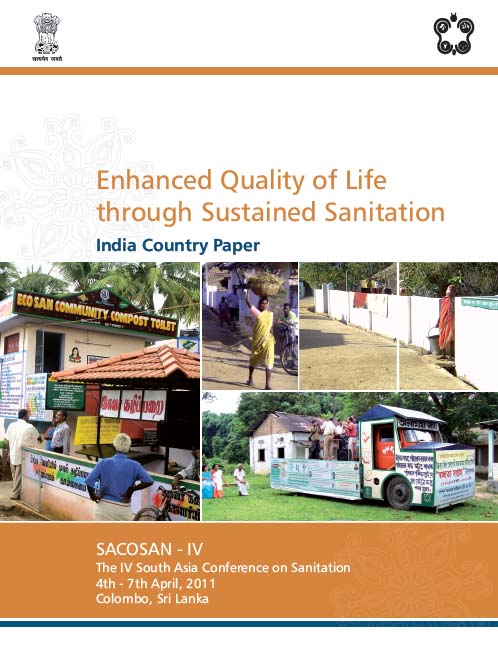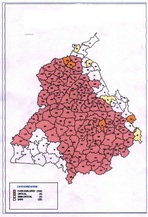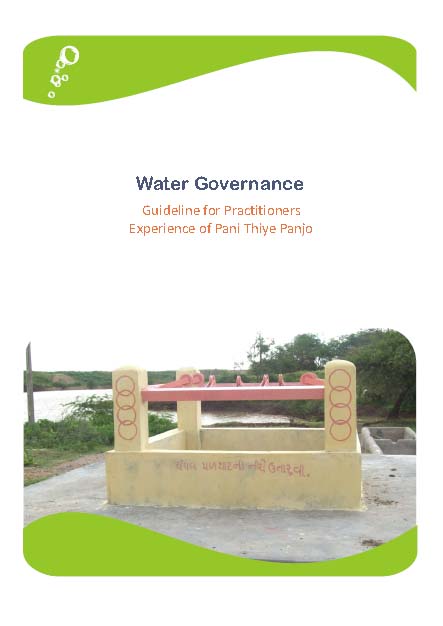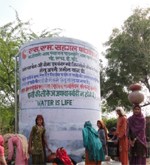Drinking and other Domestic Uses
Assessment study of impact and sustainability of Nirmal Gram Puraskar – A report by CMS Environment
Posted on 24 Jun, 2011 11:02 PMNGP was initiated in Oct 2003 to encourage Panchayati Raj Institutions (PRIs), block and districts to take up sanitation promotion, a post achievement, award-cum-fiscal incentive scheme. The eligibility criteria for the PRIs to receive NGP include: Gram Panchayats, Blocks and Districts, which achieve 100 per cent sanitation coverage in terms of: (1) 100 per cent sanitation coverage of individual households (2) 100 per cent school and anganwadis sanitation coverage (3) Free from open defecation and (4) Clean environment maintenance (liquid and solid waste management).
Enhanced quality of life through sustained sanitation - India country paper for South Asia Conference on Sanitation
Posted on 24 Jun, 2011 10:09 PM This India Country Paper on Enhanced Quality of Life through Sustained Sanitation was prepared for South Asia Conference on Sanitation (SACOSAN) IV held at Colombo, Sri Lanka in April, 2011.
This India Country Paper on Enhanced Quality of Life through Sustained Sanitation was prepared for South Asia Conference on Sanitation (SACOSAN) IV held at Colombo, Sri Lanka in April, 2011.
In rural sanitation, India’s flagship rural sanitation programme, the Total Sanitation Campaign (TSC), continues to be implemented with renewed vigour, and improvements in multiple facets of the programme. The TSC programme was given a further boost with the introduction of the Nirmal Gram Puraskar (NGP), an innovative incentive scheme for Gram Panchayats, Blocks and Districts. The rural sanitation sector has continued to receive increasing budgetary support.
Gravity based spring water supply systems in Vishakhapatnam: A sustainable solution to an age-old problem
Posted on 23 Jun, 2011 05:42 PM With an annual rainfall of more than 1200 mm, this region has truly pristine and under-developed ground water resources. The water related issues are more complex in the hilly areas. Some of the most concerning issues that affect the current water scenario in the Eastern Ghats are pollution of water sources (springs & streams) leading to poor health, illiteracy and ignorance resulting in improper hygiene and sanitation practices. The burden on women and children is also high since they have to walk a long distance to the springs/streams for fetching water.
Alternate management approaches for village water supply systems - Case studies from Maharashtra - A field note by WSP
Posted on 23 Jun, 2011 05:25 PMIt documents the approaches in a context where the state government agencies responsible for construction and management of rural water supply systems have been found to be facing limitations in O&M arrangements.
The traditional approach to provision of rural water supply in India has been supply driven, with emphasis on norms and targets and on construction and creation of assets, but with very little concern for sustainable arrangements for better management and maintenance of the facilities built. The viewpoint that users are ‘beneficiaries’ rather than empowered stakeholders among the service providers has led to alienation of the users.
Water crisis and water chaos in Punjab - An article by Umendra Dutt, Kheti Virasat Mission
Posted on 23 Jun, 2011 02:08 PM Last month Punjab has been declared as the over all best state in the country by India Today news magazine for the third conjunctive year. It is good to have a prize for Punjab and state government has immediately taken this as an opportunity to have publicity campaign for its achievement. But there is another side of the picture also which shows doom, distress and destruction is fast engulfing this land of five waters. It is a Water-Chaos in the Punjab.
Last month Punjab has been declared as the over all best state in the country by India Today news magazine for the third conjunctive year. It is good to have a prize for Punjab and state government has immediately taken this as an opportunity to have publicity campaign for its achievement. But there is another side of the picture also which shows doom, distress and destruction is fast engulfing this land of five waters. It is a Water-Chaos in the Punjab.
Water governance guidelines for practitioners - Sahjeevan's experiences in decentralised drinking water management
Posted on 20 Jun, 2011 08:50 PM This report is based on the experience of women’s collectives promoted by Sahjeevan and of several member organizations of Abhiyan on local water governance, in particular on the demonstrated models of decentralized drinking water that they have taken up in several villages.
This report is based on the experience of women’s collectives promoted by Sahjeevan and of several member organizations of Abhiyan on local water governance, in particular on the demonstrated models of decentralized drinking water that they have taken up in several villages.
Water has been the central theme for development in Kutch. In the last two decades, a scaling up process of decentralized drinking water, popularly known as Pani Thiye Panjo, has been initiated in around hundred villages of Abdasa taluka in Kutch district of Gujarat focusing on development of local drinking water sources, their strengthening and building capacities of communities for maintenance and management of the systems to develop drinking water security at the village level.
The concept of Pani Thiye Panjo, has been well accepted as Abdasa model, which besides providing drinking water security, initiated policy dialogues at the local level on issues such as protection of groundwater, pricing mechanism of water (local vis-à-vis external sources), role of Panchayati Raj Institutions in water governance, role of local youth in developing their technical capacities and development of social capital in management of drinking water systems.
Patkhori's water solutions - A case study from the work of SM Sehgal Foundation in Mewat, Haryana
Posted on 14 Jun, 2011 05:27 PM Community water tank
Community water tank
Department of Drinking Water and Sanitation, Govt. of India is looking for Deputy Adviser (PHE)
Posted on 14 Jun, 2011 01:43 PMThe Department of Drinking Water Supply complements the efforts of the State Governments in providing safe drinking water and sanitation to the rural masses of India. Programmes for drinking water supply and sanitation have been under implementation ever since the inception of the first five year plan.
Department of Drinking Water & Sanitation, Govt. of India is looking for Assistant Adviser (PHE)
Posted on 14 Jun, 2011 01:42 PMThe Department of Drinking Water Supply complements the efforts of the State Governments in providing safe drinking water and sanitation to the rural masses of India. Programmes for drinking water supply and sanitation have been under implementation ever since the inception of the first five year plan.
Department of Drinking Water & Sanitation, Govt. of India is looking for Sr. Consultants/Consultants in National Resource Centre
Posted on 14 Jun, 2011 01:42 PMThe Department of Drinking Water and Sanitation complements the efforts of the State Governments in providing safe drinking water and sanitation to the rural masses of India. Programmes for drinking water supply and sanitation have been under implementation ever since the inception of the first five year plan.
The department requires the services of the outside experts/retired government servants for appointment as non-official consultant.





